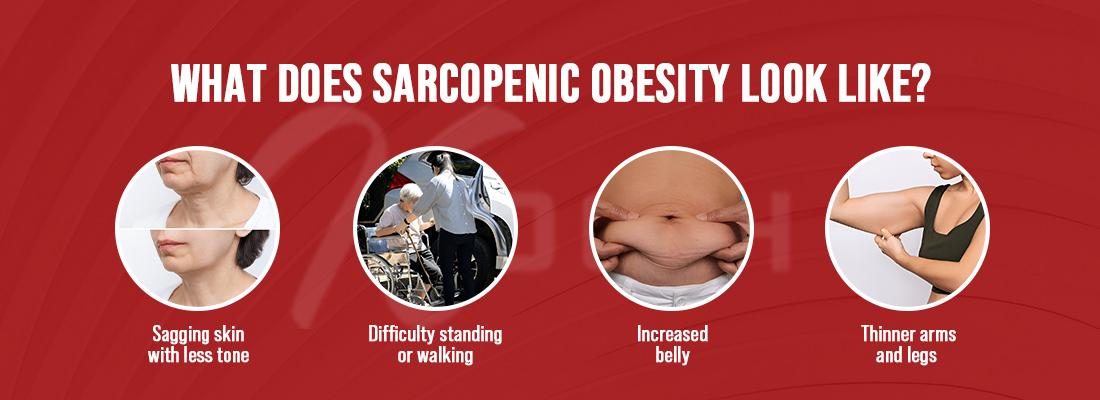
As we grow older, our bodies undergo many changes. Some of these changes may not be noticeable at first but can affect our health seriously. Likewise, one such condition that often goes unnoticed until it starts affecting everyday life is sarcopenic obesity. This is a serious health issue that combines two problems: sarcopenia (the loss of muscle mass) and obesity (excess fat accumulation).
Individually, both conditions are already harmful. But together, they can significantly impact mobility, balance, and overall health. Sarcopenic obesity is especially concerning in older adults because it can lead to weakness, reduced mobility, and a higher risk of falls.
In this blog, we’ll explore what causes sarcopenic obesity, what it looks like, and most importantly, how it can be treated effectively.
What Is Sarcopenic Obesity?
Sarcopenic obesity occurs when someone experiences muscle loss while also gaining or carrying excess body fat. This double burden weakens the body over time, reducing strength and limiting movement. While weight might appear normal or even high, the hidden muscle loss often goes undetected until physical limitations start showing.
Older adults are most vulnerable to sarcopenic obesity, particularly those over the age of 60. However, a sedentary lifestyle or poor nutrition can cause it to develop even earlier.
In more severe cases, some individuals may fall into the category of Class 3 obesity, defined by a Body Mass Index (BMI) of 40 or higher. This level of obesity further increases health risks and may accelerate muscle loss, making the effects of sarcopenic obesity more extreme and harder to reverse.
What Causes Sarcopenic Obesity In Older Adults?
There are several reasons why sarcopenic obesity develops, especially with age. Some of them are as follows;
1. Aging:
The natural aging process is a major factor. After the age of 30, muscle mass begins to decline gradually. By the time someone reaches their 60s or 70s, this loss can become quite noticeable
2. Sedentary lifestyle:
A lack of physical activity also plays a critical role. When muscles are not regularly used or challenged, they begin to shrink and weaken. At the same time, unused energy is stored as fat, further tipping the balance.
3. Poor diet:
An incomplete or poor diet is another key contributor. Older adults often consume fewer calories and less protein than their bodies need to maintain muscle. At the same time, processed and sugary foods may sneak into the diet, increasing fat storage.
4. Hormonal Changes:
As you grow old, hormone levels in your body decline. Two of the most important hormones that are responsible for maintaining muscle mass, testosterone and growth hormone, also tend to decrease significantly with age. Thus, making it difficult to preserve lean muscle and easier to gain extra fat.
5. Chronic Inflammation:
Long-term inflammation caused by obesity, diabetes, or other diseases can damage muscle tissue over time and interfere with muscle regeneration. This ongoing damage not only contributes to muscle loss but also increases fat storage and worsens metabolic health, further fueling sarcopenic obesity.
6. Insulin Resistance:
Insulin helps cells absorb glucose and nutrients, including amino acids essential for muscle growth. However, with age, many people develop insulin resistance, where cells respond poorly to insulin. This limits nutrient delivery to muscles, making it harder to build or maintain them. Meanwhile, excess glucose is stored as fat, contributing to both muscle loss and fat accumulation simultaneously.
What Does Sarcopenic Obesity Look Like?
Unlike traditional obesity, sarcopenic obesity may not always be obvious to the naked eye. Some people might not look overweight and yet still suffer from dangerously low muscle mass.
However, some common physical signs include:

Although external appearance may not always tell the full story, imaging tools like DEXA scans can confirm muscle-to-fat ratios. These scans can show just how much lean tissue has been lost, even when total body weight hasn’t changed much.
Health Risks Linked To Sarcopenic Obesity
This condition poses serious health threats if left untreated. Weak muscles and excess fat can lead to instability, increasing the risk of falls and fractures. It also raises the chances of developing:
- Metabolic diseases such as Type 2 diabetes and insulin resistance.
- Cardiovascular diseases including atherosclerosis and hypertension.
- It also contributes to respiratory diseases, osteoporosis, and poor nutritional status.
Besides physical health, sarcopenic obesity can also reduce quality of life. Even simple tasks like walking, lifting groceries, or maintaining posture become hard to perform.
How To Diagnose Sarcopenic Obesity?
Identifying sarcopenic obesity can be challenging, as it often hides behind normal body weight or mild obesity. However, it can be diagnosed using;
- Body composition tests such as DEXA scan and bioelectrical impedance analysis (BIA).
- Functional tests such as grip strength test, gait speed test, or sit-to-stand test.
- A thorough review of the person’s diet, physical activity, and medical history.
What Are Treatment Options For Sarcopenic Obesity?
Sarcopenic obesity is a serious disease that can interfere with a person’s day-to-day tasks and can lead to other serious health issues. But luckily, it’s treatable. The following are some proven ways to manage and reverse it:
Exercise:
Strength training is essential, especially for rebuilding muscle and burning excess fat. Activities like walking, stretching, and swimming also help when done regularly.
Dietary Changes:
A balanced, rich in protein diet supports muscle repair and reduces fat. Therefore, lean meats, beans, leafy greens, dairy products, and eggs should be consumed. Whereas sugary and processed foods should be limited.
Nutritional Supplements:
Supplements like vitamin D support muscle function. Other than that, Omega-3s and protein supplements may also be recommended to support muscle and bone health.
Hormone Therapy:
Some patients may benefit from hormone treatments. However, this must be done under strict medical supervision.
Regular Health Monitoring:
Routine medical checkups help track progress and adjust treatments as needed. Also, staying committed to long-term lifestyle changes is essential for lasting results.
Participation In Clinical Studies
As the healthcare world is evolving, new potential ways to overcome obesity are being explored and tested. Therefore, get yourself enrolled in Weight Loss Clinical Trials and learn new possible ways to fight off sarcopenic obesity.
Final Thoughts
Sarcopenic obesity may be silent at first, but its effects can become serious if ignored. Fortunately, early action can help slow, stop, or even reverse the condition.
By recognizing the signs, staying active, eating well, and seeking medical advice when needed, older adults can maintain strength, balance, and independence. Whether you or a loved one is showing symptoms, it’s never too late to make positive changes.
So, talk to your doctor, get the right tests, and take charge of your health today!






